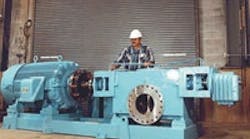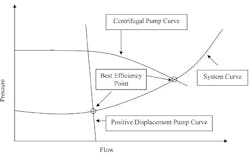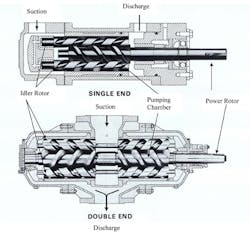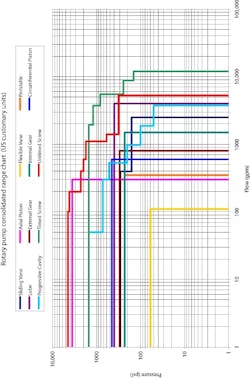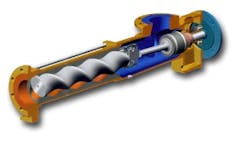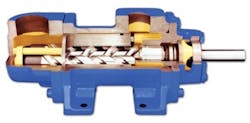Consider Positive Displacement Pumps
Most engineers are more familiar with centrifugal pumps than positive displacement pumps. In many cases, however, positive displacement pumps, particularly rotary variants, can provide the most cost-effective and efficient fluid handling. That's because, unlike centrifugal pumps, which create pressure, positive displacement pumps create flow.
In a centrifugal pump, an impeller rotates to move liquid through the process. The impeller's velocity imparts energy on the fluid. The resulting rise in pressure, or head, is proportional to the velocity of the liquid.
In contrast, a positive displacement pump moves a set volume of liquid. Pressure is created as the liquid is forced through the pump discharge into the system. The pump converts energy into pressure. This is achieved as an increasing volume within the pumping chamber is opened to suction and then is filled, closed, moved to discharge and displaced. The delivered capacity is nearly constant throughout the discharge pressure range. This constant capacity or flow will intersect a system curve at a defined point, allowing a high degree of control (Figure 1).
Some flow variation may occur due to internal slip or pump wear. Slip stems from the fluid's viscosity and the system pressure — with lower viscosity or higher discharge pressure creating more internal slip. Pump wear also results in increased slip. Many factors contribute to wear, including the nature and abrasiveness of the liquid pumped, pressure and age.
It's important to note that a rotary unit will continue to pump if there's a downstream blockage. So, rotary systems require some type of safety pressure-relief valve at or immediately downstream of the pump to protect against over-pressure.
ROTARY PUMPS
Positive displacement pumps come in many different types. Here, we'll focus on rotary pumps. The Hydraulic Institute categorizes rotary units in seven primary segments — vane, piston, flexible member, lobe, gear, circumferential piston and screw; this breakdown helps in understanding the various nuances of pump design and operation. (The Hydraulic Institute also provides family trees for kinetic (such as centrifugal), vertical (submersible), sealless centrifugal (canned motor), reciprocating power (horizontal or vertical) and direct acting (horizontal or vertical) pumps.)
Rotary pump types differ in internal components but all operate on similar principles to create flow, as typified by the single- and doubled-ended three-screw pumps shown in Figure 2: liquid enters at suction and moves axially through the pump to discharge; the volume of each pumping chamber determines the amount of liquid delivered.
Table 1 summarizes the method of operation, advantages and limitations of each type. Treat the comments in the table as a rough guide; direct specific questions or comments to vendors being considered.
Figure 3 depicts the pressure-versus-flow capabilities of types of rotary pumps. The ranges and the maximum values shown aren't absolute; custom designs with alternate speeds, clearances or special materials may exceed these values. To learn more, visit the Hydraulic Institute at www.pumps.org.
SCREW PUMPS
These devices are further divided into two segments: single-screw (progressing cavity) and multiple-screw. Multiple-screw pumps, in turn, are classified as timed or untimed. Each of these variants offers distinct advantages and limitations (Table 2).
Let's look at each type in a bit more detail:
Single-screw (progressing cavity). This design most commonly is fitted with a rigid threaded rotor that rotates within an elastomeric stator with internal threads (Figure 4). Although capable of pumping water, it's most effective in handling contaminated and viscous fluids. So, this pump finds wide use in wastewater service and typically is the unit of choice for sludge, as well as abrasive or stringy fluids where the constant flow characteristics of a positive displacement pump are preferred. Sanitary 3A-rated stainless steel versions handle a wide range of food products from meat to dairy, molasses to concentrated juices.
A unique feature of this pump to keep in mind is the option of an auger feeder fit into a hopper-style inlet. This allows the pump to handle up to 45% solids' content. Not many types of pumps can deal with non-fluids such as recycled tires — but a progressing cavity pump can.
The benefits of the progressing cavity pump include:
• suitability for abrasive fluids;
• ability to handle solids and stringy material;
• metering capability;
• availability of sanitary-service designs; and
• low shear.
Timed multiple-screw. The two- or twin-screw pump (Figure 5) typifies this design. Unlike in a single-screw unit, the twin-screw pump's rotor doesn't contact the casing. In fact, there's no metal-to-metal contact between the rotors themselves or the rotors and casing. Rotors are precision machined and supported by bearings synchronized by oil-lubricated timing gears on one end of the rotors. This sophisticated design means the twin-screw pump isn't a low cost option but enables it to handle difficult applications when other designs fail. It truly can be the pump of last resort.
Advantages of the timed twin-screw pump include:
• ability to handle extremely high to water-thin viscosities (such as required for some flushing cycles);
• capability (of some designs) to cope with multiphase feeds (fluid, gas and contaminants);
• ability to provide high flow rates;
• extremely low NPSHR (net positive suction head required), well suiting it for difficult vapor pressure fluid applications;
• high temperature capability;
• extremely low pressure pulse;
• contamination tolerance;
• producible in any metal that can be machined; and
• typically run at full motor speeds even for high flow rates.
This is the design to consider for difficult applications, particularly when two or more of the above factors are important.
Untimed multiple-screw. This technology most often comes with three screws — one power rotor and two idlers (Figure 6). It also is available in two-, four- and five-rotor versions. All designs operate with the same principle — that is, with the rotor and idler(s) run in a close-fitting housing. The epicycloidal geometry of the rotor set assures a rolling contact; the rotor set runs inside the bore of the casing much like a journal bearing. A film of the liquid being pumped prevents contact of the rotating elements and the bore. Most designs feature axial and radial balancing. Thrust bearings aren't required. When applied and operated properly, such pumps provide a very long service life between maintenance cycles. Units typically are made of iron and steel, and so shouldn't be used in corrosive applications. Also, except for some special designs, this technology only suits contaminant-free fluids.
Unlike the other screw designs, the untimed multiple-screw can accommodate a magnetic coupling for guaranteed leak-free performance. Such pumps handle applications such as machinery lubrication, fluid power hydraulics, fuel injection and compressor seal systems; some special designs are used for high-pressure water-based applications.
Advantages of untimed multiple-screw pumps include:
• very low noise and pulsation;
• high efficiency;
• operation at full motor speed even at high flow rates (allowing application of a smaller pump without gear reducer);
• self priming;
• high reliability (balanced design); and
• ability to be applied on rotating equipment driven by auxiliary shaft at speeds above two-pole motor speeds.
SELECTION GUIDELINES
When evaluating the pump type for your fluid handling system, focus on four key aspects, namely, fluid, discharge, supply and operating objectives. The following general guidelines indicate when a positive displacement pump may be a good choice:
Fluid. Will your pump see liquid viscosities of greater than 20 centistokes, entrained gas or deal with a shear-sensitive liquid? If so, consider a positive displacement pump for its ability to handle high viscosity liquids more efficiently, i.e., with lower annual energy costs, than centrifugal pumps.
Discharge. Will pressure vary in your system? If so, consider a positive displacement pump for its ability to deliver a nearly constant volume of liquid over the pressure range.
Supply. Will supply conditions vary in your system? If so, consider a positive displacement pump for its versatility in handling a wide range of NPSHA (net positive suction head available), fluid characteristics and ability to adjust speed efficiently.
Operating. Will your flow or pressure demands change occasionally or even frequently? If so, consider a positive displacement pump because of its ability to respond immediately and efficiently to pressure changes and varied speed.
Selecting the right pump type is important — but so too is properly sizing the pump. Many engineers don't appreciate the importance of sizing a pump only to meet the application's requirements. It's common to oversize a pump, for example, in anticipation of future planned expansions. This leads to higher initial and energy costs.
In making a decision on the best pump for the job, take the time to consider suitability, efficiency, reliability, and, perhaps most importantly, the total cost of ownership. A pump's original price may not amount to much compared to the cost of energy and maintenance over its life.
SEAN McCANDLESS is oil and gas market manager for Colfax Fluid Handling, Monroe, N.C. RICHARD MEIGHAN is director, product sales, power generation and industrial markets, for Colfax in Monroe. E-mail them at [email protected] and[email protected].
